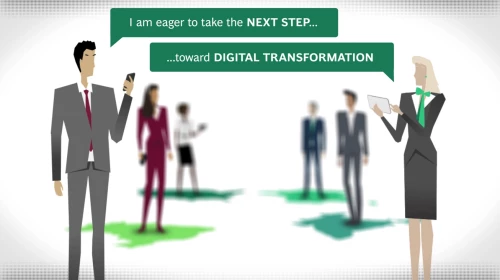Since publication of “The Digital Imperative,” we have heard from CEOs around the world who are eager to take the next step toward digital transformation. Most executives tell us they understand why their companies need to transform, but the question remains: how do they make it happen?
Transformation can be an audacious undertaking. To compete in the fast-moving digital world, companies need to execute along three dimensions:
- Speed. How can we move quickly—at digital speed?
- Scale. How can we change the way we work across the entire enterprise?
- Value. How can we create tangible value for the business—and for customers?
Let’s take a closer look at how some companies are securing advantage with these three strategies.
Speed
A leading bank needed to shorten its development period without compromising quality or compliance. It created cross-functional teams made up of business and technology experts. These new teams had the freedom to embrace agile principles and design a product as they saw fit. They quickly created prototypes and put these in front of users. Acting on real-time feedback, they learned what customers wanted. By implementing these new processes, the bank released better products in approximately half the time, while maintaining compliance and improving quality.
Scale
The toy industry has been hit hard by digital disruption. After struggling significantly in the middle of the first decade of the 21st century, LEGO, the well-known Danish toy company, has reestablished itself as a leader in the industry. LEGO’s digital-services platform has played a crucial role by facilitating faster innovation, efficient supply-chain processes, and customer intimacy. It supports loosely coupled microservices to provide digital functionality in a flexible, scalable, 24-7 environment.
Streamlined decision making, empowered business leaders, and a global collaborative culture are other important elements in LEGO’s digital transformation. The company found smart ways to enhance its core physical products with digital elements and uses digital technology to crowdsource product design ideas through communities of designers and customers, thus staying aware and ahead of emerging trends and accelerating time to market.
Value
Transport for London (TfL) is responsible for all public transit in London. Leaders of TfL wanted to create an app to help customers navigate the city’s public transportation, but they needed to keep costs low. So they opened up TfL’s transportation data to third-party developers instead of spending public funds. Since the program launched in 2009, more than 8,000 developers have signed up for it.
One local startup, Citymapper, used TfL’s data to create an urban navigation app that has become the goto resource for Londoners. Since then, Citymapper has expanded to cover more than 30 cities globally. Overall, every £1 invested by TfL in its open-data framework has yielded over 50 pounds in benefits for Londoners. By embracing open data, TfL created much greater value for its customers, and did so much more quickly than it could have on its own—while also creating extraordinary opportunities for startups like Citymapper.





